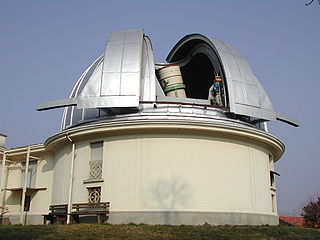See also
| Astronomy by |
| ||||||||||
|---|---|---|---|---|---|---|---|---|---|---|---|
| Optical telescopes | |||||||||||
| Related | |||||||||||

The Kitt Peak National Observatory (KPNO) is a United States astronomical observatory located on Kitt Peak of the Quinlan Mountains in the Arizona-Sonoran Desert on the Tohono Oʼodham Nation, 88 kilometers (55 mi) west-southwest of Tucson, Arizona. With more than twenty optical and two radio telescopes, it is one of the largest gatherings of astronomical instruments in the Earth's northern hemisphere.

A primary mirror is the principal light-gathering surface of a reflecting telescope.

A refracting telescope is a type of optical telescope that uses a lens as its objective to form an image. The refracting telescope design was originally used in spyglasses and astronomical telescopes but is also used for long-focus camera lenses. Although large refracting telescopes were very popular in the second half of the 19th century, for most research purposes, the refracting telescope has been superseded by the reflecting telescope, which allows larger apertures. A refractor's magnification is calculated by dividing the focal length of the objective lens by that of the eyepiece.

A reflecting telescope is a telescope that uses a single or a combination of curved mirrors that reflect light and form an image. The reflecting telescope was invented in the 17th century by Isaac Newton as an alternative to the refracting telescope which, at that time, was a design that suffered from severe chromatic aberration. Although reflecting telescopes produce other types of optical aberrations, it is a design that allows for very large diameter objectives. Almost all of the major telescopes used in astronomy research are reflectors. Many variant forms are in use and some employ extra optical elements to improve image quality or place the image in a mechanically advantageous position. Since reflecting telescopes use mirrors, the design is sometimes referred to as a catoptric telescope.

The Anglo-Australian Telescope (AAT) is a 3.9-metre equatorially mounted telescope operated by the Australian Astronomical Observatory and situated at the Siding Spring Observatory, Australia, at an altitude of a little over 1,100 m. In 2009, the telescope was ranked as having the fifth-highest-impact of the world's optical telescopes. In 2001–2003, it was considered the most scientifically productive 4-metre-class optical telescope in the world based on scientific publications using data from the telescope.

The ESA Optical Ground Station is the European Space Agency's ground based observatory at the Teide Observatory on Tenerife, Spain, built for the observation of space debris. OGS is part of the Artemis experiment and is operated by the IAC and Ataman Science S.L.U.

The Otto Struve Telescope was the first major telescope to be built at McDonald Observatory. Located in the Davis Mountains in West Texas, the Otto Struve Telescope was designed by Warner & Swasey Company and constructed between 1933 and 1939 by the Paterson-Leitch Company. Its 82-inch (2.1 m) mirror was the second largest in the world at the time. It was named after the Russian-American astronomer Otto Struve in 1966, three years after his death; Struve had been the director of McDonald Observatory from 1932–1950.

A telescope is a device used to observe distant objects by their emission, absorption, or reflection of electromagnetic radiation. Originally it was an optical instrument using lenses, curved mirrors, or a combination of both to observe distant objects – an optical telescope. Nowadays, the word "telescope" is defined as wide range of instruments capable of detecting different regions of the electromagnetic spectrum, and in some cases other types of detectors.

Merate Astronomical Observatory is an old observatory in Merate (Lecco), Italy. It has housed a 1-meter Zeiss telescope since 1926.

The James Gregory Telescope was constructed in 1962 by the University of St Andrews. It is of a Schmidt-Cassegrain design and is fitted with a CCD camera. The telescope has very large field of view, compared even to regular 'wide field' designs, and can view 5 square degrees.

The Víctor M. Blanco Telescope, also known as the Blanco 4m, is a 4-metre aperture telescope located at the Cerro Tololo Inter-American Observatory, Chile on the summit of Mt. Cerro Tololo. Commissioned in 1974 and completed in 1976, the telescope is identical to the Mayall 4m telescope located on Kitt Peak. In 1995 it was dedicated and named in honour of Puerto Rican astronomer Víctor Manuel Blanco. It was the largest optical telescope in the Southern hemisphere from 1976 until 1998, when the first 8-metre telescope of the ESO Very Large Telescope opened.

This is a list of lists of telescopes.